Corporations Law Assignment: Case Analysis and Remedies
VerifiedAdded on 2022/09/16
|10
|2350
|22
Homework Assignment
AI Summary
This document provides a comprehensive analysis of a corporations law assignment, addressing various aspects of Canadian business law. It includes detailed answers to questions regarding contract enforceability, pre-contractual misrepresentation, and remedies available to parties. The assignment covers topics such as breach of contract, damages, and the termination of contracts. Additionally, it explores different business structures like sole proprietorships and partnerships, comparing their advantages. The document also examines the concept of the corporate veil, and its implications. It discusses the roles of directors and shareholders, and relevant case law, offering a thorough understanding of corporations law in a Canadian context.
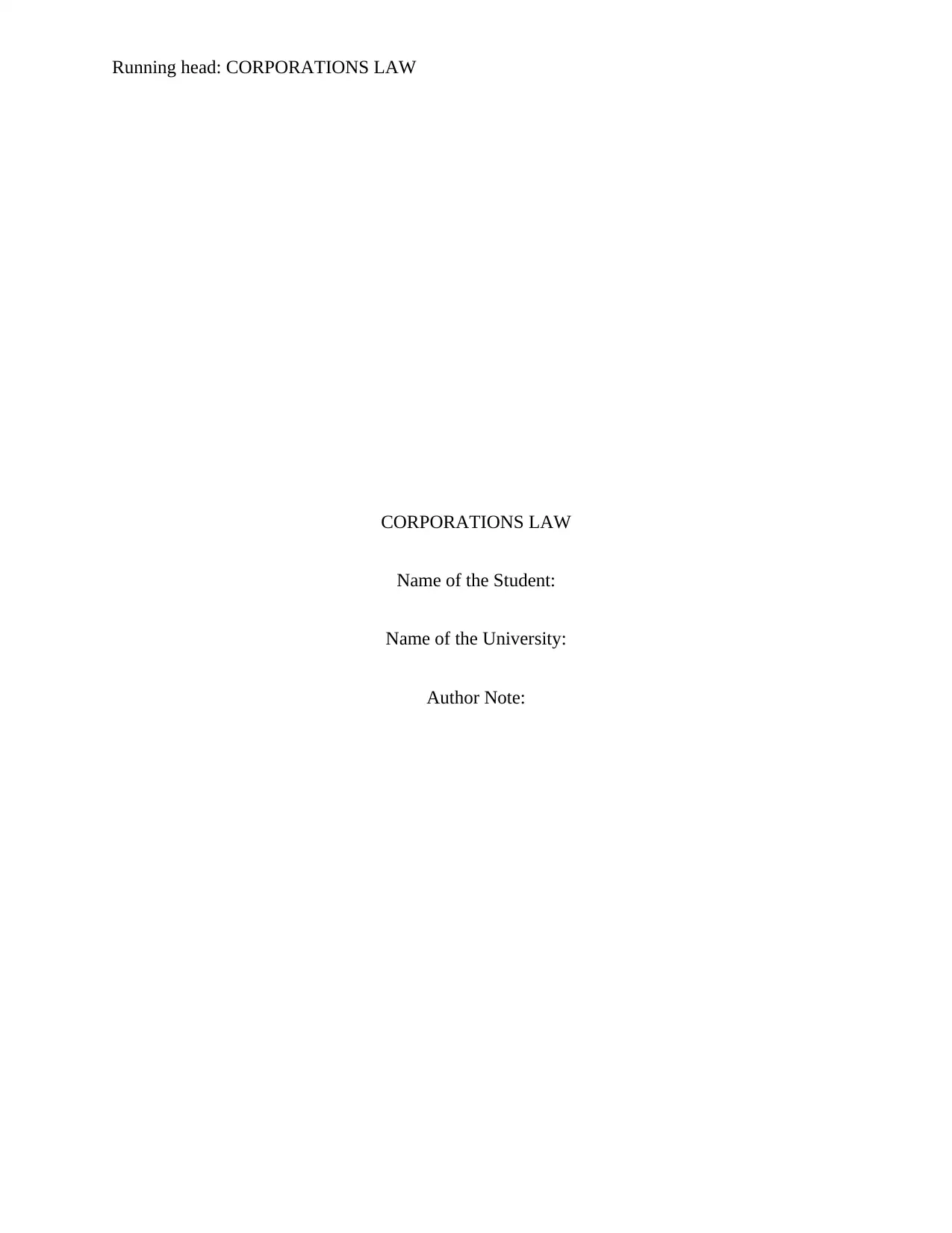
Running head: CORPORATIONS LAW
CORPORATIONS LAW
Name of the Student:
Name of the University:
Author Note:
CORPORATIONS LAW
Name of the Student:
Name of the University:
Author Note:
Paraphrase This Document
Need a fresh take? Get an instant paraphrase of this document with our AI Paraphraser
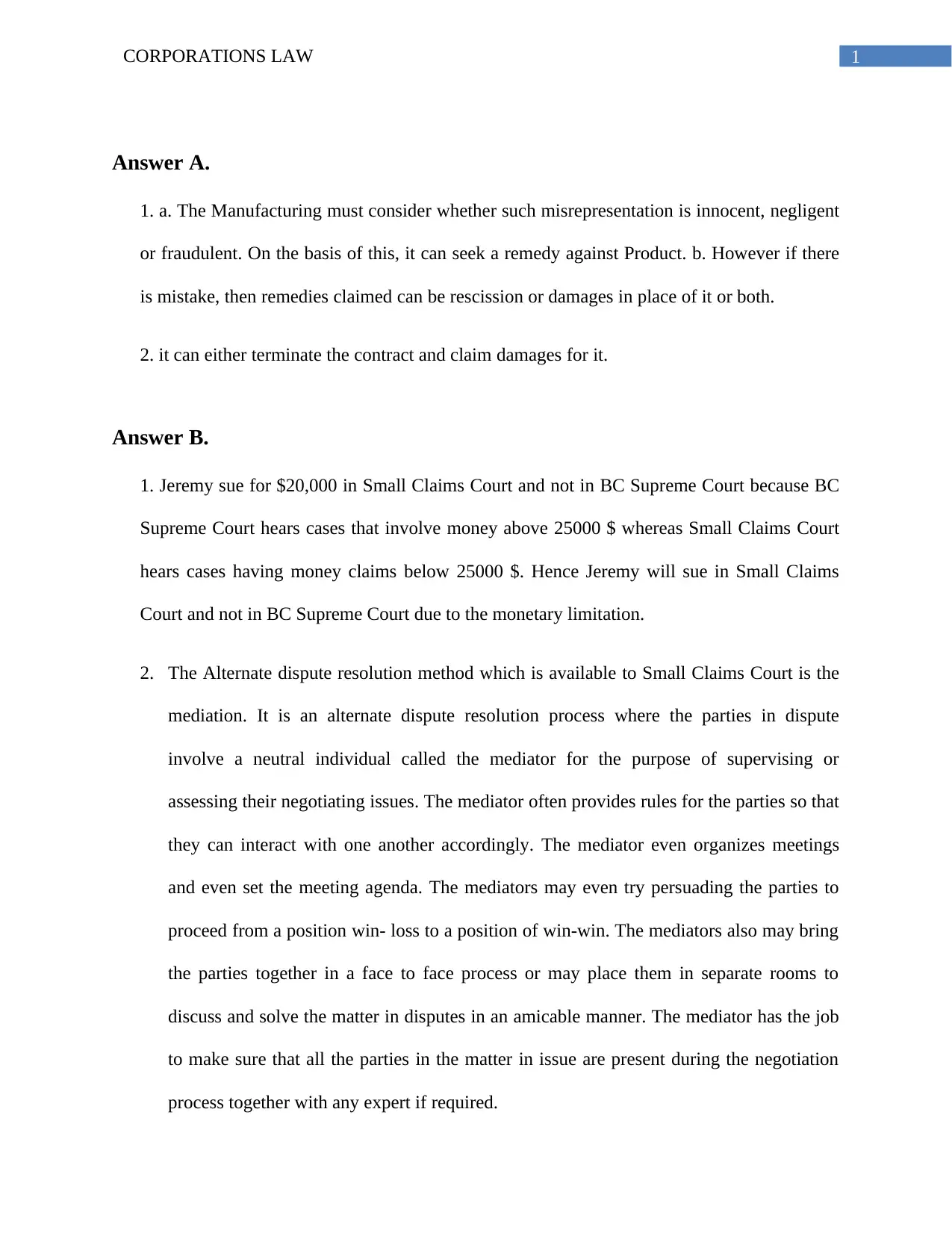
1CORPORATIONS LAW
Answer A.
1. a. The Manufacturing must consider whether such misrepresentation is innocent, negligent
or fraudulent. On the basis of this, it can seek a remedy against Product. b. However if there
is mistake, then remedies claimed can be rescission or damages in place of it or both.
2. it can either terminate the contract and claim damages for it.
Answer B.
1. Jeremy sue for $20,000 in Small Claims Court and not in BC Supreme Court because BC
Supreme Court hears cases that involve money above 25000 $ whereas Small Claims Court
hears cases having money claims below 25000 $. Hence Jeremy will sue in Small Claims
Court and not in BC Supreme Court due to the monetary limitation.
2. The Alternate dispute resolution method which is available to Small Claims Court is the
mediation. It is an alternate dispute resolution process where the parties in dispute
involve a neutral individual called the mediator for the purpose of supervising or
assessing their negotiating issues. The mediator often provides rules for the parties so that
they can interact with one another accordingly. The mediator even organizes meetings
and even set the meeting agenda. The mediators may even try persuading the parties to
proceed from a position win- loss to a position of win-win. The mediators also may bring
the parties together in a face to face process or may place them in separate rooms to
discuss and solve the matter in disputes in an amicable manner. The mediator has the job
to make sure that all the parties in the matter in issue are present during the negotiation
process together with any expert if required.
Answer A.
1. a. The Manufacturing must consider whether such misrepresentation is innocent, negligent
or fraudulent. On the basis of this, it can seek a remedy against Product. b. However if there
is mistake, then remedies claimed can be rescission or damages in place of it or both.
2. it can either terminate the contract and claim damages for it.
Answer B.
1. Jeremy sue for $20,000 in Small Claims Court and not in BC Supreme Court because BC
Supreme Court hears cases that involve money above 25000 $ whereas Small Claims Court
hears cases having money claims below 25000 $. Hence Jeremy will sue in Small Claims
Court and not in BC Supreme Court due to the monetary limitation.
2. The Alternate dispute resolution method which is available to Small Claims Court is the
mediation. It is an alternate dispute resolution process where the parties in dispute
involve a neutral individual called the mediator for the purpose of supervising or
assessing their negotiating issues. The mediator often provides rules for the parties so that
they can interact with one another accordingly. The mediator even organizes meetings
and even set the meeting agenda. The mediators may even try persuading the parties to
proceed from a position win- loss to a position of win-win. The mediators also may bring
the parties together in a face to face process or may place them in separate rooms to
discuss and solve the matter in disputes in an amicable manner. The mediator has the job
to make sure that all the parties in the matter in issue are present during the negotiation
process together with any expert if required.
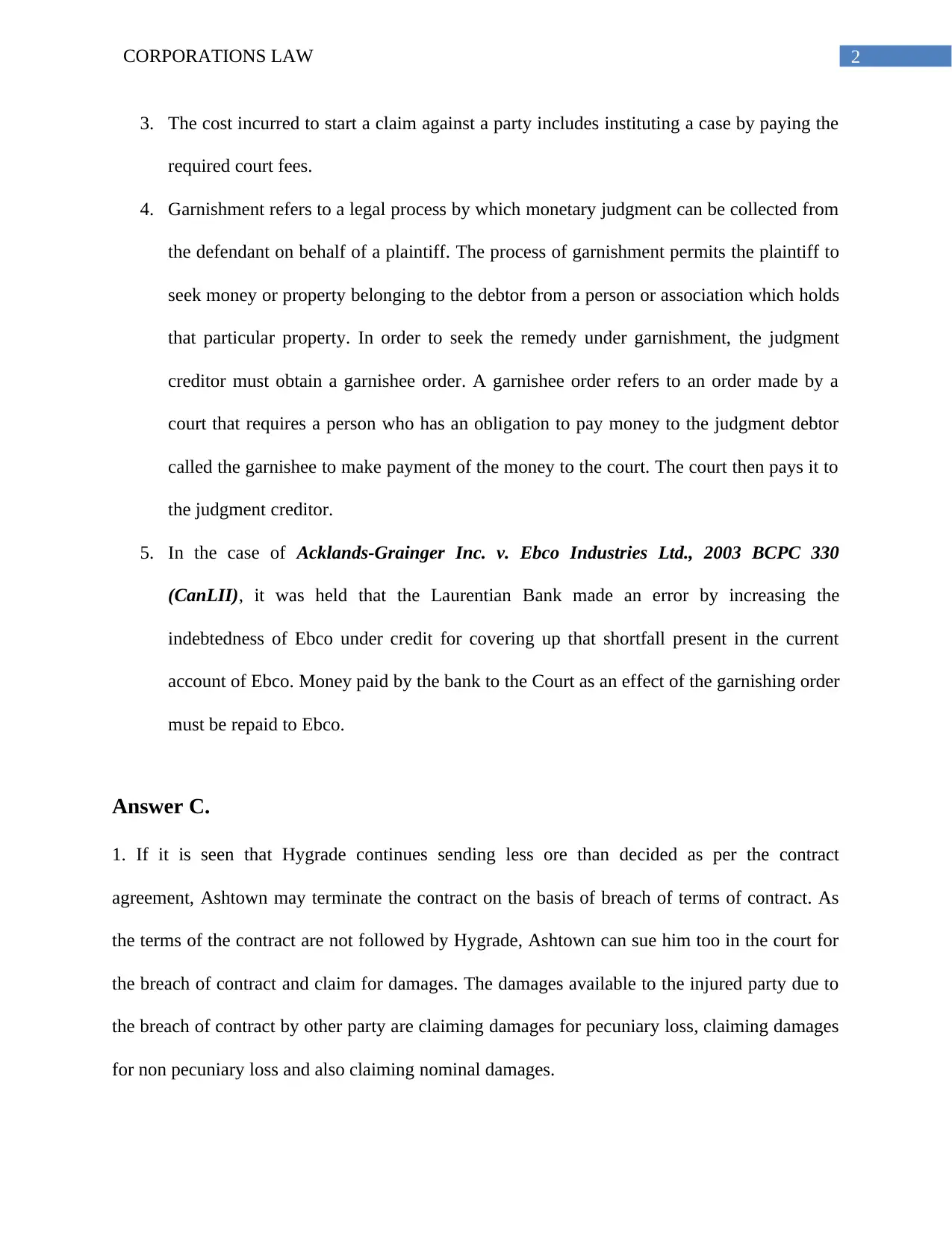
2CORPORATIONS LAW
3. The cost incurred to start a claim against a party includes instituting a case by paying the
required court fees.
4. Garnishment refers to a legal process by which monetary judgment can be collected from
the defendant on behalf of a plaintiff. The process of garnishment permits the plaintiff to
seek money or property belonging to the debtor from a person or association which holds
that particular property. In order to seek the remedy under garnishment, the judgment
creditor must obtain a garnishee order. A garnishee order refers to an order made by a
court that requires a person who has an obligation to pay money to the judgment debtor
called the garnishee to make payment of the money to the court. The court then pays it to
the judgment creditor.
5. In the case of Acklands-Grainger Inc. v. Ebco Industries Ltd., 2003 BCPC 330
(CanLII), it was held that the Laurentian Bank made an error by increasing the
indebtedness of Ebco under credit for covering up that shortfall present in the current
account of Ebco. Money paid by the bank to the Court as an effect of the garnishing order
must be repaid to Ebco.
Answer C.
1. If it is seen that Hygrade continues sending less ore than decided as per the contract
agreement, Ashtown may terminate the contract on the basis of breach of terms of contract. As
the terms of the contract are not followed by Hygrade, Ashtown can sue him too in the court for
the breach of contract and claim for damages. The damages available to the injured party due to
the breach of contract by other party are claiming damages for pecuniary loss, claiming damages
for non pecuniary loss and also claiming nominal damages.
3. The cost incurred to start a claim against a party includes instituting a case by paying the
required court fees.
4. Garnishment refers to a legal process by which monetary judgment can be collected from
the defendant on behalf of a plaintiff. The process of garnishment permits the plaintiff to
seek money or property belonging to the debtor from a person or association which holds
that particular property. In order to seek the remedy under garnishment, the judgment
creditor must obtain a garnishee order. A garnishee order refers to an order made by a
court that requires a person who has an obligation to pay money to the judgment debtor
called the garnishee to make payment of the money to the court. The court then pays it to
the judgment creditor.
5. In the case of Acklands-Grainger Inc. v. Ebco Industries Ltd., 2003 BCPC 330
(CanLII), it was held that the Laurentian Bank made an error by increasing the
indebtedness of Ebco under credit for covering up that shortfall present in the current
account of Ebco. Money paid by the bank to the Court as an effect of the garnishing order
must be repaid to Ebco.
Answer C.
1. If it is seen that Hygrade continues sending less ore than decided as per the contract
agreement, Ashtown may terminate the contract on the basis of breach of terms of contract. As
the terms of the contract are not followed by Hygrade, Ashtown can sue him too in the court for
the breach of contract and claim for damages. The damages available to the injured party due to
the breach of contract by other party are claiming damages for pecuniary loss, claiming damages
for non pecuniary loss and also claiming nominal damages.
⊘ This is a preview!⊘
Do you want full access?
Subscribe today to unlock all pages.

Trusted by 1+ million students worldwide
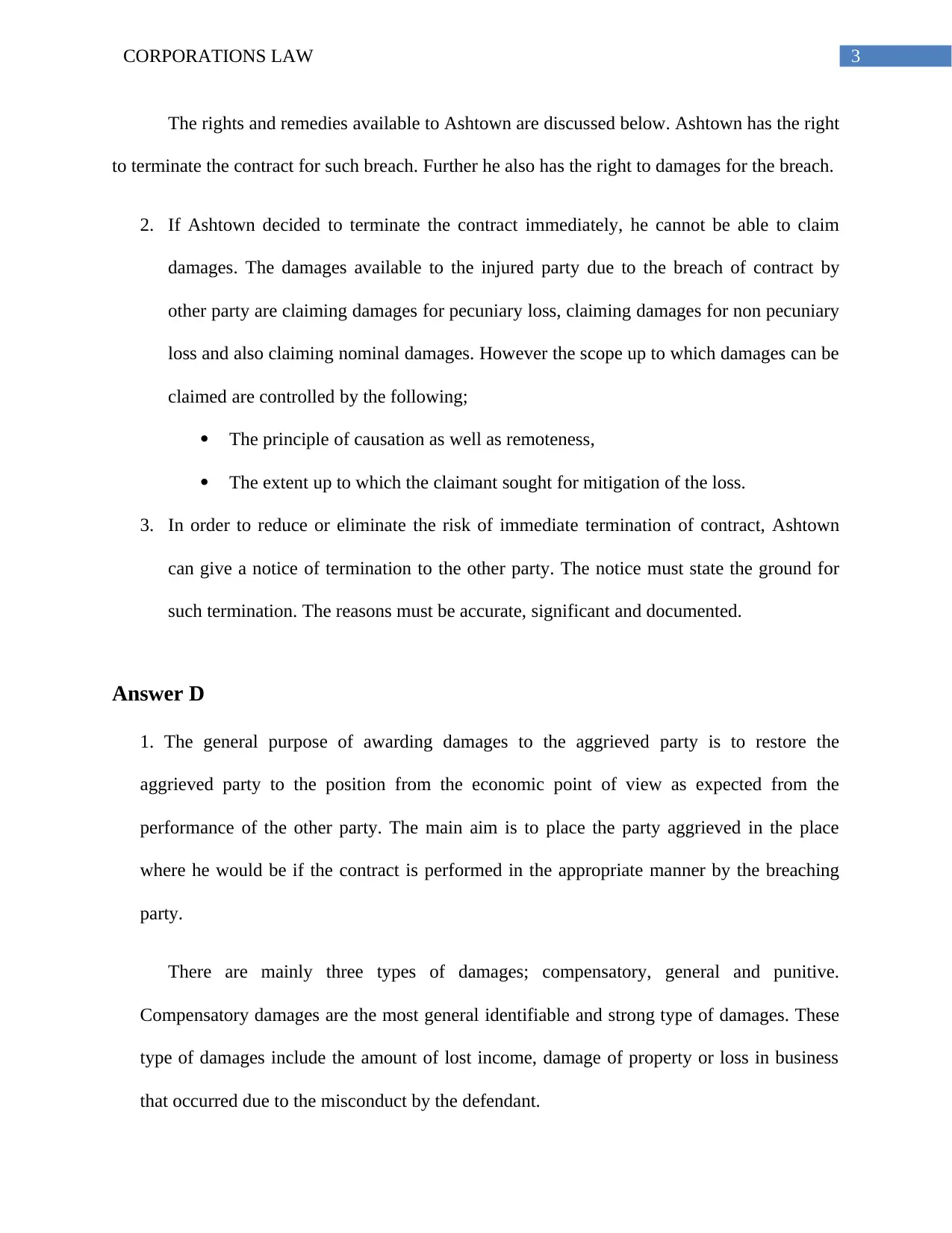
3CORPORATIONS LAW
The rights and remedies available to Ashtown are discussed below. Ashtown has the right
to terminate the contract for such breach. Further he also has the right to damages for the breach.
2. If Ashtown decided to terminate the contract immediately, he cannot be able to claim
damages. The damages available to the injured party due to the breach of contract by
other party are claiming damages for pecuniary loss, claiming damages for non pecuniary
loss and also claiming nominal damages. However the scope up to which damages can be
claimed are controlled by the following;
The principle of causation as well as remoteness,
The extent up to which the claimant sought for mitigation of the loss.
3. In order to reduce or eliminate the risk of immediate termination of contract, Ashtown
can give a notice of termination to the other party. The notice must state the ground for
such termination. The reasons must be accurate, significant and documented.
Answer D
1. The general purpose of awarding damages to the aggrieved party is to restore the
aggrieved party to the position from the economic point of view as expected from the
performance of the other party. The main aim is to place the party aggrieved in the place
where he would be if the contract is performed in the appropriate manner by the breaching
party.
There are mainly three types of damages; compensatory, general and punitive.
Compensatory damages are the most general identifiable and strong type of damages. These
type of damages include the amount of lost income, damage of property or loss in business
that occurred due to the misconduct by the defendant.
The rights and remedies available to Ashtown are discussed below. Ashtown has the right
to terminate the contract for such breach. Further he also has the right to damages for the breach.
2. If Ashtown decided to terminate the contract immediately, he cannot be able to claim
damages. The damages available to the injured party due to the breach of contract by
other party are claiming damages for pecuniary loss, claiming damages for non pecuniary
loss and also claiming nominal damages. However the scope up to which damages can be
claimed are controlled by the following;
The principle of causation as well as remoteness,
The extent up to which the claimant sought for mitigation of the loss.
3. In order to reduce or eliminate the risk of immediate termination of contract, Ashtown
can give a notice of termination to the other party. The notice must state the ground for
such termination. The reasons must be accurate, significant and documented.
Answer D
1. The general purpose of awarding damages to the aggrieved party is to restore the
aggrieved party to the position from the economic point of view as expected from the
performance of the other party. The main aim is to place the party aggrieved in the place
where he would be if the contract is performed in the appropriate manner by the breaching
party.
There are mainly three types of damages; compensatory, general and punitive.
Compensatory damages are the most general identifiable and strong type of damages. These
type of damages include the amount of lost income, damage of property or loss in business
that occurred due to the misconduct by the defendant.
Paraphrase This Document
Need a fresh take? Get an instant paraphrase of this document with our AI Paraphraser
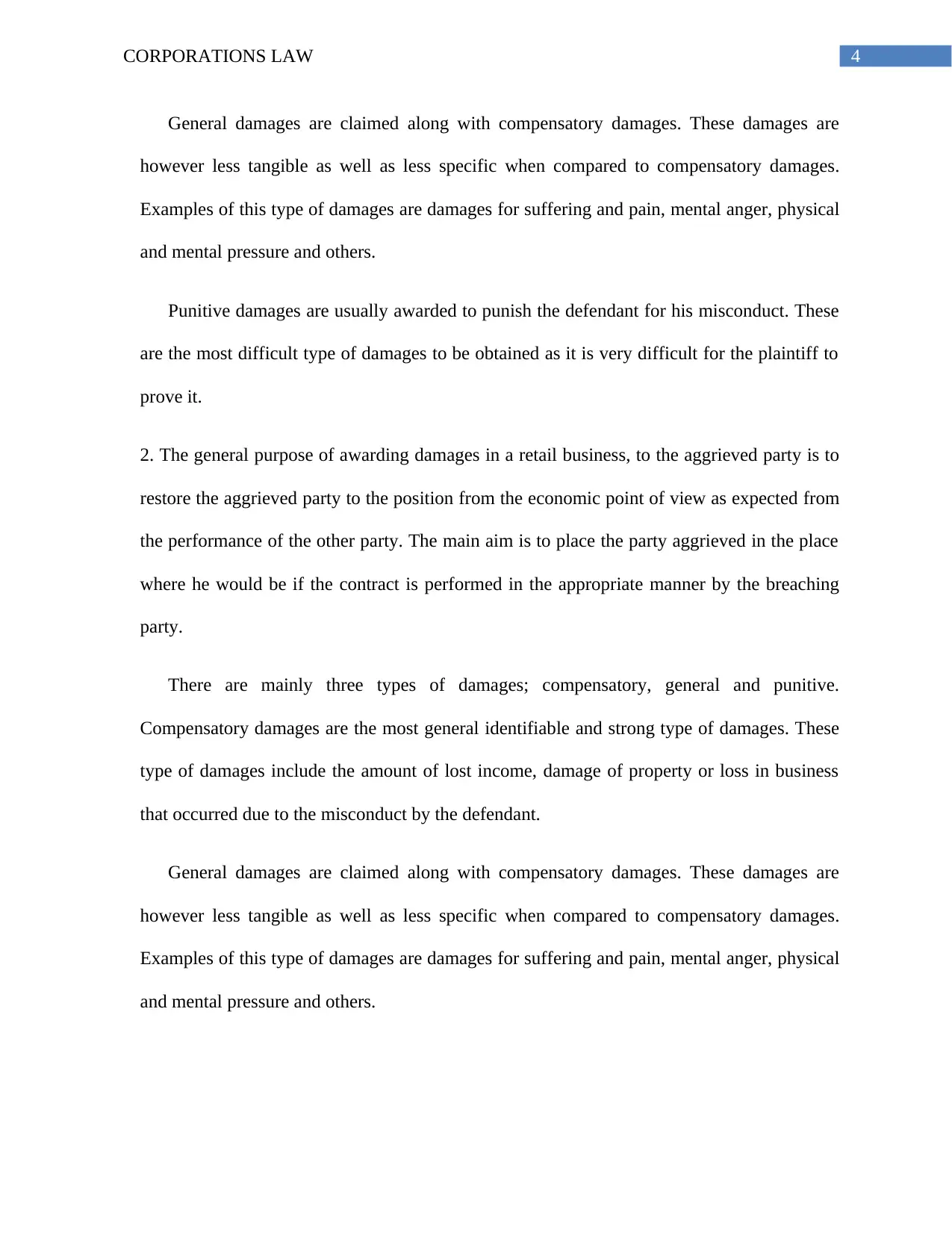
4CORPORATIONS LAW
General damages are claimed along with compensatory damages. These damages are
however less tangible as well as less specific when compared to compensatory damages.
Examples of this type of damages are damages for suffering and pain, mental anger, physical
and mental pressure and others.
Punitive damages are usually awarded to punish the defendant for his misconduct. These
are the most difficult type of damages to be obtained as it is very difficult for the plaintiff to
prove it.
2. The general purpose of awarding damages in a retail business, to the aggrieved party is to
restore the aggrieved party to the position from the economic point of view as expected from
the performance of the other party. The main aim is to place the party aggrieved in the place
where he would be if the contract is performed in the appropriate manner by the breaching
party.
There are mainly three types of damages; compensatory, general and punitive.
Compensatory damages are the most general identifiable and strong type of damages. These
type of damages include the amount of lost income, damage of property or loss in business
that occurred due to the misconduct by the defendant.
General damages are claimed along with compensatory damages. These damages are
however less tangible as well as less specific when compared to compensatory damages.
Examples of this type of damages are damages for suffering and pain, mental anger, physical
and mental pressure and others.
General damages are claimed along with compensatory damages. These damages are
however less tangible as well as less specific when compared to compensatory damages.
Examples of this type of damages are damages for suffering and pain, mental anger, physical
and mental pressure and others.
Punitive damages are usually awarded to punish the defendant for his misconduct. These
are the most difficult type of damages to be obtained as it is very difficult for the plaintiff to
prove it.
2. The general purpose of awarding damages in a retail business, to the aggrieved party is to
restore the aggrieved party to the position from the economic point of view as expected from
the performance of the other party. The main aim is to place the party aggrieved in the place
where he would be if the contract is performed in the appropriate manner by the breaching
party.
There are mainly three types of damages; compensatory, general and punitive.
Compensatory damages are the most general identifiable and strong type of damages. These
type of damages include the amount of lost income, damage of property or loss in business
that occurred due to the misconduct by the defendant.
General damages are claimed along with compensatory damages. These damages are
however less tangible as well as less specific when compared to compensatory damages.
Examples of this type of damages are damages for suffering and pain, mental anger, physical
and mental pressure and others.
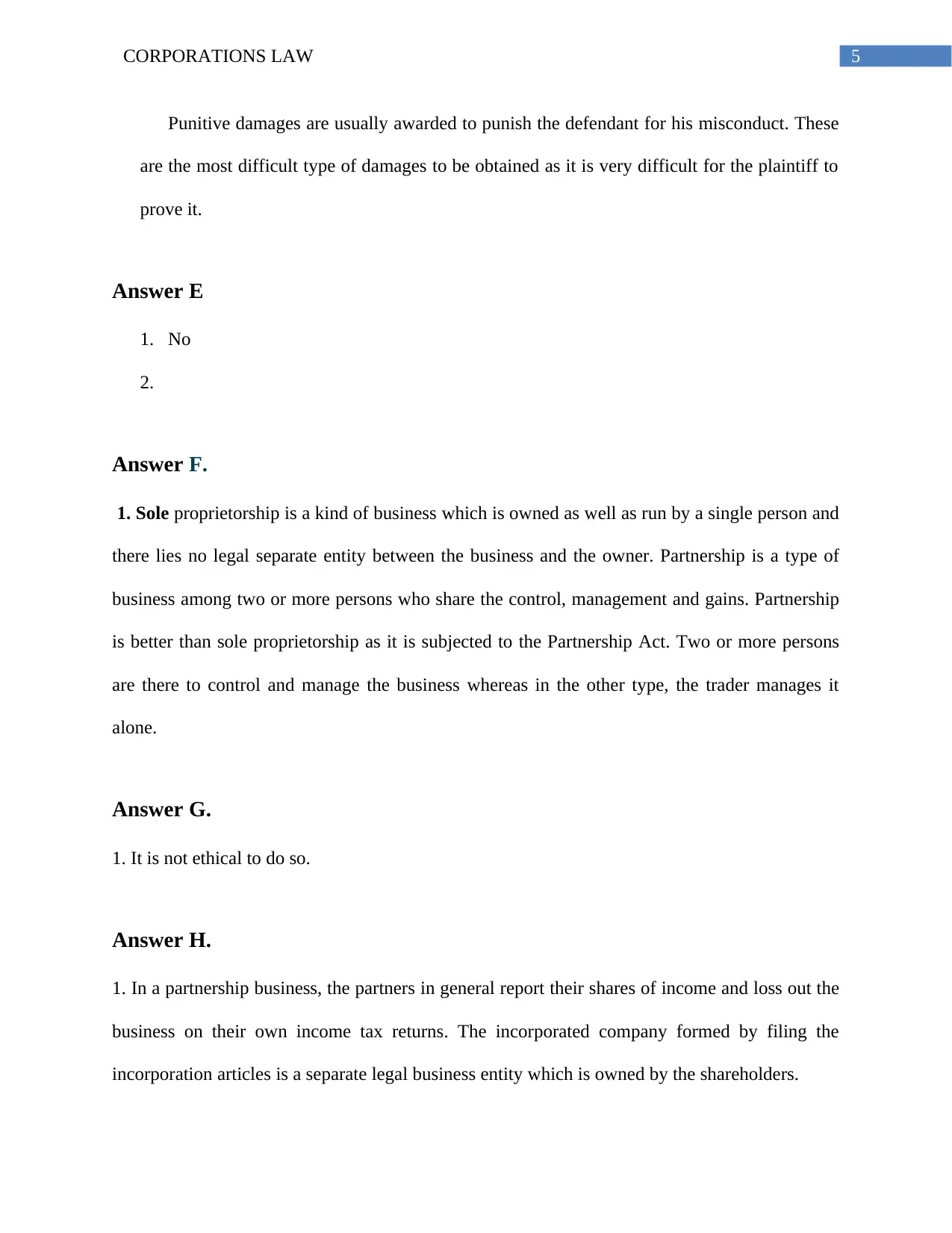
5CORPORATIONS LAW
Punitive damages are usually awarded to punish the defendant for his misconduct. These
are the most difficult type of damages to be obtained as it is very difficult for the plaintiff to
prove it.
Answer E
1. No
2.
Answer F.
1. Sole proprietorship is a kind of business which is owned as well as run by a single person and
there lies no legal separate entity between the business and the owner. Partnership is a type of
business among two or more persons who share the control, management and gains. Partnership
is better than sole proprietorship as it is subjected to the Partnership Act. Two or more persons
are there to control and manage the business whereas in the other type, the trader manages it
alone.
Answer G.
1. It is not ethical to do so.
Answer H.
1. In a partnership business, the partners in general report their shares of income and loss out the
business on their own income tax returns. The incorporated company formed by filing the
incorporation articles is a separate legal business entity which is owned by the shareholders.
Punitive damages are usually awarded to punish the defendant for his misconduct. These
are the most difficult type of damages to be obtained as it is very difficult for the plaintiff to
prove it.
Answer E
1. No
2.
Answer F.
1. Sole proprietorship is a kind of business which is owned as well as run by a single person and
there lies no legal separate entity between the business and the owner. Partnership is a type of
business among two or more persons who share the control, management and gains. Partnership
is better than sole proprietorship as it is subjected to the Partnership Act. Two or more persons
are there to control and manage the business whereas in the other type, the trader manages it
alone.
Answer G.
1. It is not ethical to do so.
Answer H.
1. In a partnership business, the partners in general report their shares of income and loss out the
business on their own income tax returns. The incorporated company formed by filing the
incorporation articles is a separate legal business entity which is owned by the shareholders.
⊘ This is a preview!⊘
Do you want full access?
Subscribe today to unlock all pages.

Trusted by 1+ million students worldwide
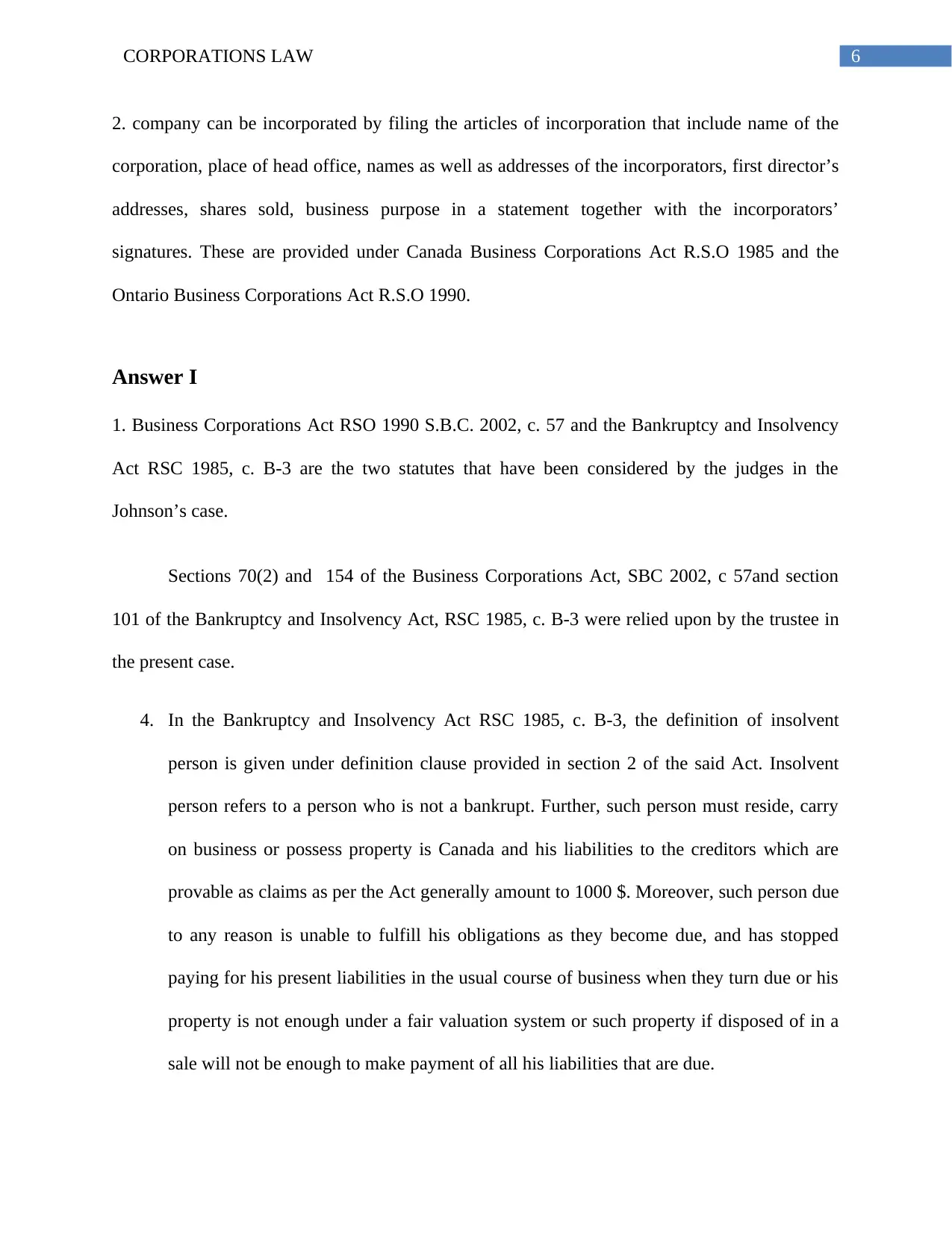
6CORPORATIONS LAW
2. company can be incorporated by filing the articles of incorporation that include name of the
corporation, place of head office, names as well as addresses of the incorporators, first director’s
addresses, shares sold, business purpose in a statement together with the incorporators’
signatures. These are provided under Canada Business Corporations Act R.S.O 1985 and the
Ontario Business Corporations Act R.S.O 1990.
Answer I
1. Business Corporations Act RSO 1990 S.B.C. 2002, c. 57 and the Bankruptcy and Insolvency
Act RSC 1985, c. B-3 are the two statutes that have been considered by the judges in the
Johnson’s case.
Sections 70(2) and 154 of the Business Corporations Act, SBC 2002, c 57and section
101 of the Bankruptcy and Insolvency Act, RSC 1985, c. B-3 were relied upon by the trustee in
the present case.
4. In the Bankruptcy and Insolvency Act RSC 1985, c. B-3, the definition of insolvent
person is given under definition clause provided in section 2 of the said Act. Insolvent
person refers to a person who is not a bankrupt. Further, such person must reside, carry
on business or possess property is Canada and his liabilities to the creditors which are
provable as claims as per the Act generally amount to 1000 $. Moreover, such person due
to any reason is unable to fulfill his obligations as they become due, and has stopped
paying for his present liabilities in the usual course of business when they turn due or his
property is not enough under a fair valuation system or such property if disposed of in a
sale will not be enough to make payment of all his liabilities that are due.
2. company can be incorporated by filing the articles of incorporation that include name of the
corporation, place of head office, names as well as addresses of the incorporators, first director’s
addresses, shares sold, business purpose in a statement together with the incorporators’
signatures. These are provided under Canada Business Corporations Act R.S.O 1985 and the
Ontario Business Corporations Act R.S.O 1990.
Answer I
1. Business Corporations Act RSO 1990 S.B.C. 2002, c. 57 and the Bankruptcy and Insolvency
Act RSC 1985, c. B-3 are the two statutes that have been considered by the judges in the
Johnson’s case.
Sections 70(2) and 154 of the Business Corporations Act, SBC 2002, c 57and section
101 of the Bankruptcy and Insolvency Act, RSC 1985, c. B-3 were relied upon by the trustee in
the present case.
4. In the Bankruptcy and Insolvency Act RSC 1985, c. B-3, the definition of insolvent
person is given under definition clause provided in section 2 of the said Act. Insolvent
person refers to a person who is not a bankrupt. Further, such person must reside, carry
on business or possess property is Canada and his liabilities to the creditors which are
provable as claims as per the Act generally amount to 1000 $. Moreover, such person due
to any reason is unable to fulfill his obligations as they become due, and has stopped
paying for his present liabilities in the usual course of business when they turn due or his
property is not enough under a fair valuation system or such property if disposed of in a
sale will not be enough to make payment of all his liabilities that are due.
Paraphrase This Document
Need a fresh take? Get an instant paraphrase of this document with our AI Paraphraser
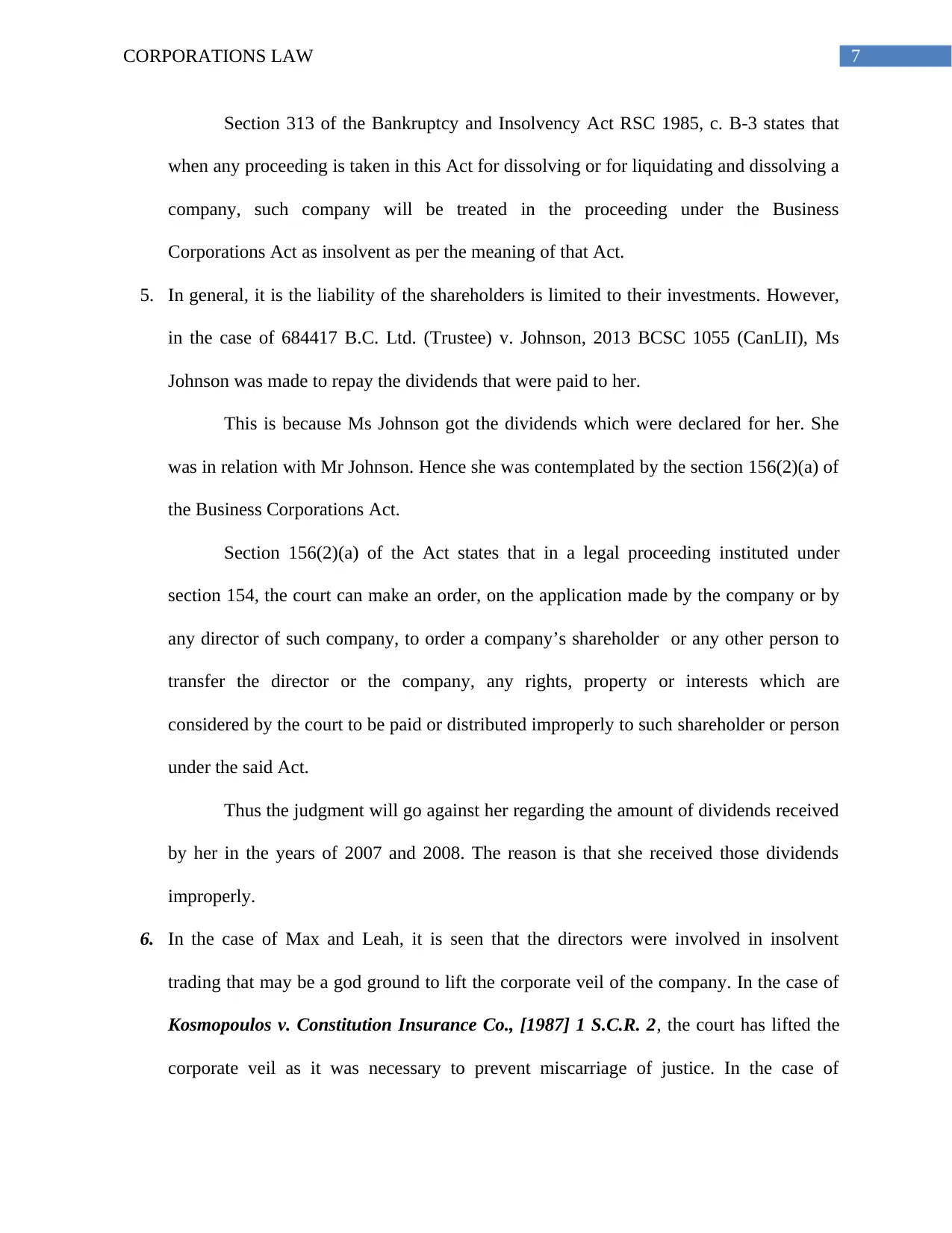
7CORPORATIONS LAW
Section 313 of the Bankruptcy and Insolvency Act RSC 1985, c. B-3 states that
when any proceeding is taken in this Act for dissolving or for liquidating and dissolving a
company, such company will be treated in the proceeding under the Business
Corporations Act as insolvent as per the meaning of that Act.
5. In general, it is the liability of the shareholders is limited to their investments. However,
in the case of 684417 B.C. Ltd. (Trustee) v. Johnson, 2013 BCSC 1055 (CanLII), Ms
Johnson was made to repay the dividends that were paid to her.
This is because Ms Johnson got the dividends which were declared for her. She
was in relation with Mr Johnson. Hence she was contemplated by the section 156(2)(a) of
the Business Corporations Act.
Section 156(2)(a) of the Act states that in a legal proceeding instituted under
section 154, the court can make an order, on the application made by the company or by
any director of such company, to order a company’s shareholder or any other person to
transfer the director or the company, any rights, property or interests which are
considered by the court to be paid or distributed improperly to such shareholder or person
under the said Act.
Thus the judgment will go against her regarding the amount of dividends received
by her in the years of 2007 and 2008. The reason is that she received those dividends
improperly.
6. In the case of Max and Leah, it is seen that the directors were involved in insolvent
trading that may be a god ground to lift the corporate veil of the company. In the case of
Kosmopoulos v. Constitution Insurance Co., [1987] 1 S.C.R. 2, the court has lifted the
corporate veil as it was necessary to prevent miscarriage of justice. In the case of
Section 313 of the Bankruptcy and Insolvency Act RSC 1985, c. B-3 states that
when any proceeding is taken in this Act for dissolving or for liquidating and dissolving a
company, such company will be treated in the proceeding under the Business
Corporations Act as insolvent as per the meaning of that Act.
5. In general, it is the liability of the shareholders is limited to their investments. However,
in the case of 684417 B.C. Ltd. (Trustee) v. Johnson, 2013 BCSC 1055 (CanLII), Ms
Johnson was made to repay the dividends that were paid to her.
This is because Ms Johnson got the dividends which were declared for her. She
was in relation with Mr Johnson. Hence she was contemplated by the section 156(2)(a) of
the Business Corporations Act.
Section 156(2)(a) of the Act states that in a legal proceeding instituted under
section 154, the court can make an order, on the application made by the company or by
any director of such company, to order a company’s shareholder or any other person to
transfer the director or the company, any rights, property or interests which are
considered by the court to be paid or distributed improperly to such shareholder or person
under the said Act.
Thus the judgment will go against her regarding the amount of dividends received
by her in the years of 2007 and 2008. The reason is that she received those dividends
improperly.
6. In the case of Max and Leah, it is seen that the directors were involved in insolvent
trading that may be a god ground to lift the corporate veil of the company. In the case of
Kosmopoulos v. Constitution Insurance Co., [1987] 1 S.C.R. 2, the court has lifted the
corporate veil as it was necessary to prevent miscarriage of justice. In the case of
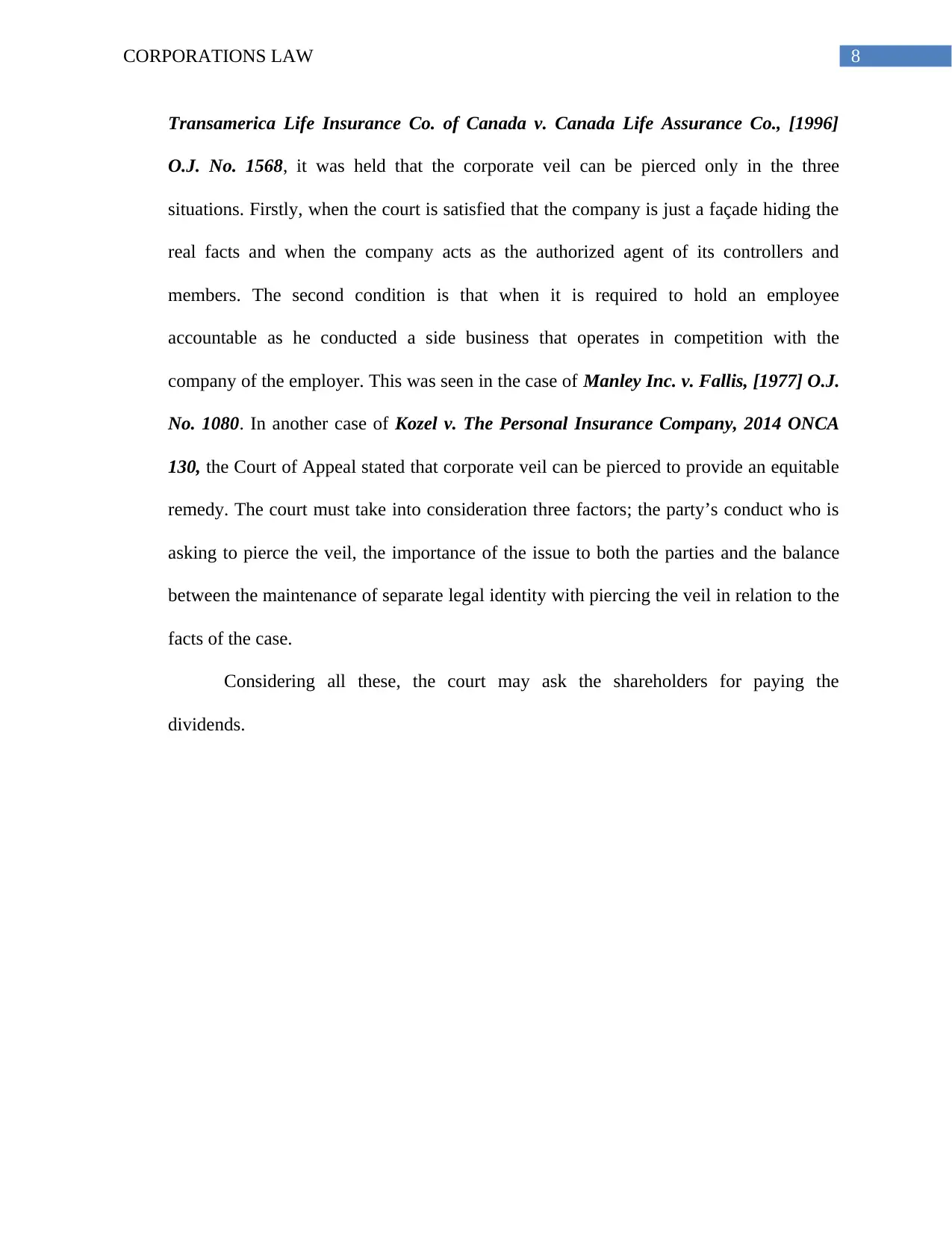
8CORPORATIONS LAW
Transamerica Life Insurance Co. of Canada v. Canada Life Assurance Co., [1996]
O.J. No. 1568, it was held that the corporate veil can be pierced only in the three
situations. Firstly, when the court is satisfied that the company is just a façade hiding the
real facts and when the company acts as the authorized agent of its controllers and
members. The second condition is that when it is required to hold an employee
accountable as he conducted a side business that operates in competition with the
company of the employer. This was seen in the case of Manley Inc. v. Fallis, [1977] O.J.
No. 1080. In another case of Kozel v. The Personal Insurance Company, 2014 ONCA
130, the Court of Appeal stated that corporate veil can be pierced to provide an equitable
remedy. The court must take into consideration three factors; the party’s conduct who is
asking to pierce the veil, the importance of the issue to both the parties and the balance
between the maintenance of separate legal identity with piercing the veil in relation to the
facts of the case.
Considering all these, the court may ask the shareholders for paying the
dividends.
Transamerica Life Insurance Co. of Canada v. Canada Life Assurance Co., [1996]
O.J. No. 1568, it was held that the corporate veil can be pierced only in the three
situations. Firstly, when the court is satisfied that the company is just a façade hiding the
real facts and when the company acts as the authorized agent of its controllers and
members. The second condition is that when it is required to hold an employee
accountable as he conducted a side business that operates in competition with the
company of the employer. This was seen in the case of Manley Inc. v. Fallis, [1977] O.J.
No. 1080. In another case of Kozel v. The Personal Insurance Company, 2014 ONCA
130, the Court of Appeal stated that corporate veil can be pierced to provide an equitable
remedy. The court must take into consideration three factors; the party’s conduct who is
asking to pierce the veil, the importance of the issue to both the parties and the balance
between the maintenance of separate legal identity with piercing the veil in relation to the
facts of the case.
Considering all these, the court may ask the shareholders for paying the
dividends.
⊘ This is a preview!⊘
Do you want full access?
Subscribe today to unlock all pages.

Trusted by 1+ million students worldwide
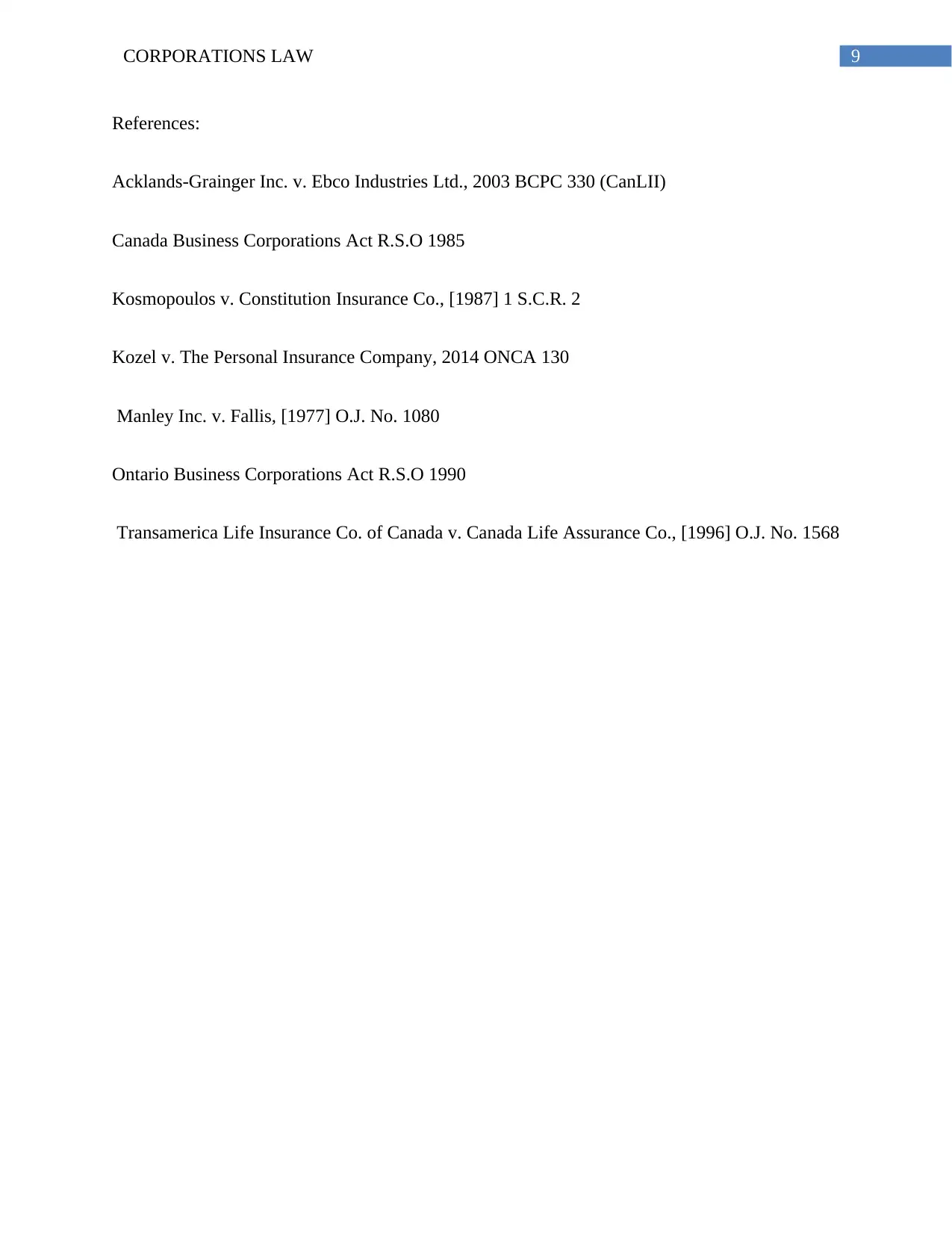
9CORPORATIONS LAW
References:
Acklands-Grainger Inc. v. Ebco Industries Ltd., 2003 BCPC 330 (CanLII)
Canada Business Corporations Act R.S.O 1985
Kosmopoulos v. Constitution Insurance Co., [1987] 1 S.C.R. 2
Kozel v. The Personal Insurance Company, 2014 ONCA 130
Manley Inc. v. Fallis, [1977] O.J. No. 1080
Ontario Business Corporations Act R.S.O 1990
Transamerica Life Insurance Co. of Canada v. Canada Life Assurance Co., [1996] O.J. No. 1568
References:
Acklands-Grainger Inc. v. Ebco Industries Ltd., 2003 BCPC 330 (CanLII)
Canada Business Corporations Act R.S.O 1985
Kosmopoulos v. Constitution Insurance Co., [1987] 1 S.C.R. 2
Kozel v. The Personal Insurance Company, 2014 ONCA 130
Manley Inc. v. Fallis, [1977] O.J. No. 1080
Ontario Business Corporations Act R.S.O 1990
Transamerica Life Insurance Co. of Canada v. Canada Life Assurance Co., [1996] O.J. No. 1568
1 out of 10
Your All-in-One AI-Powered Toolkit for Academic Success.
+13062052269
info@desklib.com
Available 24*7 on WhatsApp / Email
![[object Object]](/_next/static/media/star-bottom.7253800d.svg)
Unlock your academic potential
Copyright © 2020–2025 A2Z Services. All Rights Reserved. Developed and managed by ZUCOL.
